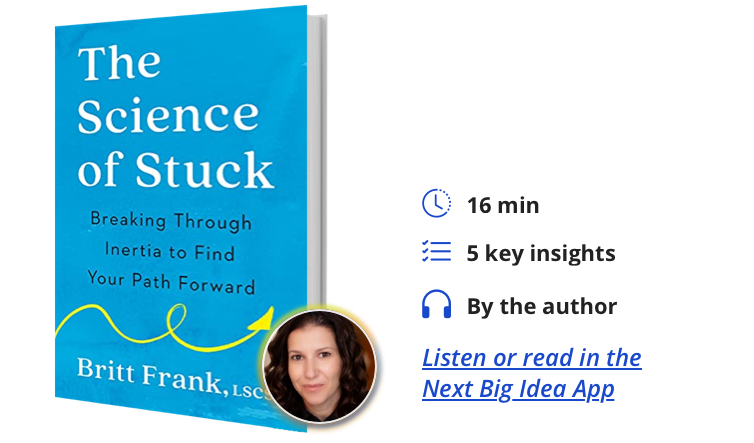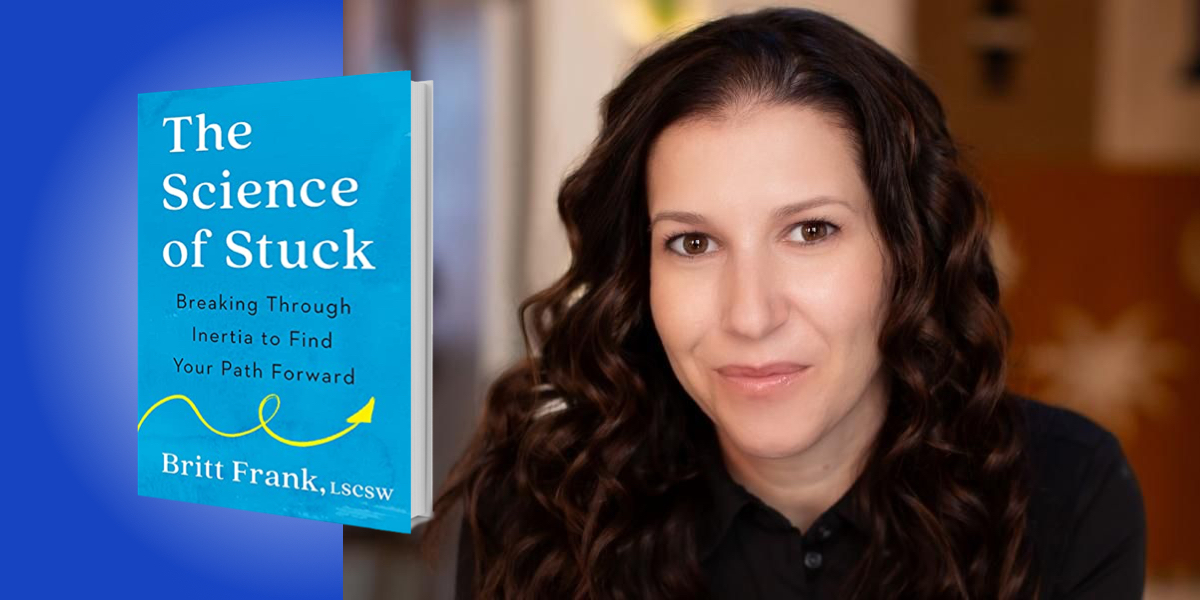Britt Frank is a licensed psychotherapist, trauma specialist, educator, and former addict. She is an award-winning adjunct professor for her time teaching at the University of Kansas. She also speaks and writes widely about achieving and maintaining emotional wellness.
Below, Britt shares 5 key insights from her new book, The Science of Stuck: Breaking Through Inertia to Find Your Path Forward. Listen to the audio version—read by Britt herself—in the Next Big Idea App.

1. We need anxiety.
People often enter therapy suffering from severe symptoms and think that all they need is to “get rid of” their anxiety. While anxiety can be debilitating and, in some cases, must be medically managed before any other interventions can be applied, trying to get rid of anxiety is as pointless as trying to disable the smoke alarm in your home.
When your smoke alarm starts screeching, the noise is uncomfortable and inconvenient, but the alarm is not attacking the house; the noise is a sign that something needs attention. Similarly, anxiety is not a character flaw or an illness—it’s the “check engine” light on our brain’s dashboard. If we disable or mute our anxiety indicators, we won’t know where the problem is. Anxiety is a roadmap that points us towards either a real or imagined threat, pain from the past, or something in the present that needs our attention. Anxiety can lead us out of our chaos. In short, we need it.
2. Motivation is not a mindset issue.
We love to work with the logical, analytical thinking part of our brain, so as a result, we love to think our way through problems, strategize, and create action plans. Thoughts do help shape behavior and therefore reality; however, you cannot simply think your way out of “stuck.” Motivation is largely a physiological issue, not a mindset issue.
There are mechanisms inside our nervous system responsible for survival physiology, otherwise known as the “fight, flight, or freeze” responses. If you are shut down (freeze), or if you are stuck in fight or in flight (sympathetic overreaction, such as panic or racing thoughts), you are not able to think your way out because that is a physiological state. Just like you can’t think your way out of indigestion or think a car into driving if it doesn’t have gas, you can’t think happy thoughts and expect to set forth into action.
“Anxiety is not a character flaw or an illness—it’s the ‘check engine’ light on our brain’s dashboard.”
Turning the amygdala response off is the key to motivation. The amygdala is the panic button in our brain that sounds the alarm that something is wrong. Even if, logically, you don’t think you should be stuck in survival brain, this is an automatic process. Our brains are wired to identify danger and seek safety. This means if your brain, whether consciously or subconsciously, thinks you are in danger, then it will create a survival response. If your brain is perceiving a threat, it will put your system in a state of hyperarousal or shutdown, and we call that procrastination and lack of motivation.
There is no such thing as true “lack of motivation.” Our brains are either motivated to mobilize in the direction of our choosing, or mobilize toward safety.
3. Mental health is a physical process.
Language matters. “Mental” health has very little to do with our minds. A nervous system that is stuck in a state of fight, flight, or freeze will present the same exact symptoms as clinical depression or pathological anxiety. But a nervous system response is not an illness or a disorder.
Our survival physiology responses often get misdiagnosed and mislabeled as mental illnesses. The pain of our symptoms is real, and it is important to note that depression can be life-threatening and incredibly debilitating, but it is equally important to know that many of the things we call “illnesses” are often our brains doing exactly what the brain is designed to do.
There’s no shame in having a disease or illness—that’s part of the human experience. But it’s important to note that 40 million Americans are diagnosed with mental illness each year, when illness is supposed to be an outlier phenomenon. It shouldn’t be labeled as the norm. Most therapists aren’t trained in the physiology of mental health and don’t know to assess for these body responses. If we shift our language from mental health discussed as a mental process, to mental health as a physical process, then we have a greater chance of finding our way to tools that can get ourselves unstuck.
“‘Mental’ health has very little to do with our minds.”
A brain stuck in fight, flight, or freeze is not sick or disordered—it is mis-attuning to safety and danger in the environment. A brain that feels safe will seldom produce symptoms. This doesn’t mean that we don’t need therapy or medications, but it does mean that the framework we’ve historically used to view our most troubling feelings and thoughts needs to be changed to a model that is more biologically accurate, as well as empowering.
4. There is no such thing as “self-sabotage.”
We all make choices that interrupt our lives, but the phrase “self-sabotage” is a misnomer because the actions that mess up our plans, destroy our relationships, and annihilate our sanity are not intended to sabotage. Rather, these self-sabotaging behaviors are a suboptimal effort at self-protection.
Even if, logically, you don’t think you “need” protection, there are unconscious emotions and automatic physiological processes at play. What we call “self-sabotage” often happens because if you achieve a goal, things will need to change. And all change—even positive change—involves a degree of loss and grief. We are hard-wired for repetition, pattern-seeking, and habit formation, so any and all changes to our status quo can trigger a threat response by our amygdala.
Knowing that self-sabotage is a suboptimal effort at self-protection doesn’t excuse any suboptimal behaviors, but it does explain those often baffling behaviors—and behavior comprehension is required for behavior modification. Achieving any goal requires emotional risk, new boundaries in relationships, financial resources, and other risks.
“We are hard-wired for repetition, pattern-seeking, and habit formation, so any and all changes to our status quo can trigger a threat response by our amygdala.”
5. All behavior is functional.
Our habits and compulsions interfere with our ability to live our best, most productive lives. Not all behavior is acceptable, but all behavior is functional—otherwise the behavior wouldn’t exist. For instance, the functionality of a suboptimal behavior could be image preservation: if you don’t make changes, then you don’t have to change the status quo. Any change brings a degree of grief, but as modern Western people in a “just think positive, live your best life” kind of environment, the idea that we need to name the things we’re most afraid of and integrate parts of ourselves that we don’t like, all as antecedents to change, is a really hard sell.
Addiction is an example of a highly toxic, but nevertheless functional behavior. If I am addicted to a substance, behavior, person, or way of thinking, then I don’t have to deal with whatever awaits me on the other side. While the disease model of addiction is still prevalent, there is an equal amount of research indicating that addiction is not always a disease. As a former addict and as a therapist who has worked in inpatient drug rehab, I have yet to meet anyone who struggles with addiction who doesn’t also have an underlying pain point that the addiction is attempting to soothe. When you drill down beneath even the most extreme behavior, you’ll almost always find either untreated trauma or unresolved grief.
While “explanation” is not synonymous with “excuse,” it is incredibly important to know that focusing on behavior modification at the expense of behavior comprehension will almost always render us inert. Failure to identify the function of a behavior compels us to repeat the behavior. In truth, it takes way more work to avoid the work than to actually do the work. You don’t need to make giant behavioral transformations to get unstuck—getting unstuck requires tiny micro-shifts, and those shifts compound rapidly. Before you know it, you’re in motion. Once you get going, all of that wonderful cognitive work suddenly becomes powerful.
To listen to the audio version read by author Britt Frank, download the Next Big Idea App today:





























